Hydrogen Economy Development Opportunities by Inter-Organizational Digital Knowledge Networks
Abstract
:1. Introduction
- While previous studies mainly focused on the technical, economic, and environmental aspects of hydrogen-based technologies, to the best of our knowledge, this is the first study to highlight the applicability of network-based innovation management theory for hydrogen economy research. By doing so, this study concentrates on the segment of P2X technologies and provides an in-depth analysis of a P2X-related knowledge transfer and leverage case.
- By synthesizing the introduced key theories, this study extends firm-level exploration-exploitation learning theory to the inter-organizational level.
- Based on the supporting empirical data of this extension, a practical contribution is provided to P2X development, by (1) highlighting the different areas where exploitative and explorative knowledge transfer is needed among universities and industry actors, and (2) showing how digital knowledge platforms can facilitate knowledge flows among different actors in this segment.
- Different interpretations and subjects of exploitation and exploration in the P2X segment; and the role of collaborating actors (universities, industry representatives, and central “system builders”) in exploitative and explorative learning are identified during P2X technology development.
2. Materials and Methods
2.1. Theoretical Background
“How could the pace of hydrogen economy development through P2X innovation-focused, digital inter-organizational knowledge networks containing industry actors and universities be increased?”
2.2. Power-to-X and the Focal Technologies of the Research
2.3. P2X-Oriented Industry-University Collaborations
2.4. Methodology
2.4.1. Extended Case Study Method
2.4.2. Data Gathering and Analyses
- More than 30 semi-structured interviews were undertaken (with the employees of the company, stakeholders, and partners, including researchers at universities and managers of industrial partners), which lasted for 1–1.5 h. This is in line with research into similar strategic and management-related topics using the extended case study method. For example, Danneels [79] conducted 17 interviews, while Bingham et al. [81] and Tripsas and Gavetti [82] conducted 31 and 20 interviews. The interviews were guided by the main research question, considering that although Creswell [83] argued that qualitative questions come up and change continuously (in our case, partly based on the supporting quantitative analysis), even qualitative research cannot start without a plan; as such, some kind of a conceptional question is necessary [84]. The emerged sub-questions of the semi-structured interviews are listed in Appendix A. The interviews were coded using the suggested iterative approach (between data and theory) with regard to the extended case studies [79].
- Quantitative text analysis was used on the content of the R&D Technological Platform of the P2X developer company, which contained 336 knowledge elements (documented technological know-hows, innovation-related questions and ideas, and e-learning materials) as a result of the open innovation processes of the company. Based on the supporting nature of this quantitative analysis, a representational approach (and not an instrumental approach) was followed instead to identify the intended meanings of the sources. The analysis-in parallel with the interviews-mainly involved thematic and network text analysis [85], but identifying trends was also relevant because of the extended case study methods. Based on these trends, future pathways could be also explored through interviews, as exploring scenarios is becoming highly relevant in the complex and uncertain future economic system [86].
- primary source (industry/academia);
- primary technological focus (e.g., P2H);
- primary (academic or industrial) sectoral connection (e.g., bio- or chemical technology);
- primary goal (e.g., benchmarking and market research).
- data cleaning (e.g., correction of grammatical errors);
- tokenizing (removing punctuation and common words such as “the” or “some” using built-in Regex tokenization);
- phrasing (a maximum of four words, but mostly from two or three words, e.g., “anaerobic digestion”, or “solid oxide electrolysis”);
- terming (adding phrases to the term list) were conducted in the first part of the text analysis.
- Generating a document term matrix that showed whether a specific term appeared in a specific knowledge element or not and scoring terms by the attributes of the knowledge elements (e.g., their source or primary goal).
- Generating and analyzing word clouds and trend analyses according to attributes of the knowledge elements, such as their source or upload year
- Hierarchical clustering of the terms according to the attributes of their containing knowledge elements.
- To improve validity, the two-year-long research and the five-year-long time horizon were important to generate an in-depth understanding of the research area. The quantitative text analysis was needed to explore patterns in the knowledge base.
- Reliability was improved by using more than one interviewer, which was important to balance between flexibility and consistency at the same time [88]. Moreover, the volume of the analyzed text was also extensive (335 knowledge elements (separate texts), 6345 terms, 84,285 tokens in total).
- Generalizability was facilitated by the iteration of empirical data and earlier theories. It is important that, by following the iterative coding technique (similar to the grounded theory method), the authors could produce a substantive theory valid in a limited social context (e.g., innovative technology developments aiming at the hydrogen economy), rather than a more abstract, formal, general theory [89].
3. Results
3.1. Building an Inter-Organizational Network and a Digital R&D Platform
- The “innovation problem solving/idea generation” module contains questions, answers, and ideas about current and further technological developments. These are the less mature knowledge elements.
- The “digital know-how development” is useful for collaboratively codifying and developing know-hows, and collecting and storing data and information. These knowledge elements are more mature; these are, e.g., proven best practices or market data.
- The “e-learning” module has the most mature knowledge elements; the e-learning materials, which provide concrete and proven guidance for prototype and (later) plant management.
3.2. The Content of the Know-How Flows on the Platform
- At the launch of the platform (2018), prototype operation, control issues, and analyses were in focus.
- P2G technology and carbon dioxide are the most important terms in the know-how base, the reason for which is that the company mainly focuses on biological methanation technology, and carbon dioxide is a key input for methanation.
- While biogas was in focus in 2018–2020, carbon capture became dominant in the know-how development for 2020 and 2021. This is because of the startup company’s growing number of industrial partnerships and is in line with the previous research, which suggested that P2M and carbon capture (CC) could together become disruptive in the future [90].
- Renewable energy, hydrogen and methane production, system and process development, and waste heat utilization are the main topics that are constantly important in the know-how flow.
- while academic influences on the know-how flows are divergent with smaller topics in higher volume, industrial influences are converging toward decarbonization;
- the startup company has more connections to academic knowledge bases in the beginning but, with the development of the prototype and its own knowledge base, industrial partners have increasingly opened up for the startup. It resulted in further changes in the knowledge base.
3.3. Complementarities between the Knowledge Base of Industry Representatives and Universities
- Terms that often appear in know-hows from industrial sources are connected loosely to bio- or chemical technology (I1 cell in the Figure) or energy economics (I3), while know-hows from academia are often themed around these terms (A1 and A3).
- Economics, business and management-related know-hows are mostly from industrial knowledge sources (I2), while academic sources hardly appear on these topics in the P2X segment (A2). This result can be explained by the early-stage nature of several P2X technologies, which are not sufficiently mature yet to generate business problems to be studied by researchers.
- Regarding engineering, industrial sources were more dominant in the data, but this difference compared to academia is weaker. Based on the interviews, this is because the startup began its activity on a prototype level focusing on biotechnology, while engineering becomes (became) increasingly relevant when scaling up the technology.
- primary technological focus, which contained five categories: P2H, P2M, P2G (P2H + P2M), P2L, and CC
- primary goal of the knowledge/know-how development (benchmarking and marketing research, business development, scientific research, technology development, training).
4. Discussion
4.1. Exploitative and Explorative Learning in the P2X Segment
- exploitation can be interpreted as:
- the utilization of the core technological know-how base of the startup company on a commercial scale (P2H and P2M with biological methanation). This interpretation is supported by the technology readiness levels (TRL) as well. For example, low-temperature electrolysis (AEL, PEMEL) are at TRL9 [92], and there are grid-scale P2M plants as well [43,44];
- exploration can be interpreted as:
- developing carbon capture solutions, which could solve the challenge of scaling up the methanation technologies, as sourcing CO2 is a critical input factor [8]. Moreover, CO2 can be also required for P2L processes. The main carbon capture strategies are well known (post-combustion, pre-combustion, and oxyfuel combustion), but there are different TRLs in the case of concrete solutions [97] and their implementation on a commercial scale is also rare.
- (1)
- collaborative because of the heterogeneous knowledge base that is hardly owned by one company or university;
- (2)
- and explorative because of the complexity of these new, integrated systems.
4.2. The Role of System Builders, Academic Partners, and Industrial Partners
4.3. Analyzing the Correctness of the Presumption
- There is a need for a system builder (e.g., a technology developer startup), who connects academic and industrial partners, integrates and participates in exploitative and explorative learning activities at different levels (own company, large energy company, and sector level), and so facilitates the formation of a(n) (digital) innovation ecosystem for technological know-how flows.
- Exploitation and exploration can have different interpretations at company level and at sector level. Even though P2X technology development as a whole means exploration for the energy sector or the innovation ecosystem, and certain technologies can be more mature, for certain organizations these technologies require either exploitative learning for startups, or explorative learning for large energy companies.
- Universities could contribute to exploitative learning (e.g., in the case of the commercialization of P2H and P2M with incremental improvements for higher efficiency), and large energy companies could contribute to explorative learning (e.g., by driving the development of CC solutions) as well.
- The subjects of exploitation and exploration change over time, both on a company and a sector level. While P2G meant exploration five years ago, it can mean exploitation today, as TRLs are high enough and business models become viable. CC, which could solve challenges about CO2 input for P2M and P2L, thus facilitating the more extensive use of renewable hydrogen, became one of the key areas of exploration.
5. Conclusions
Author Contributions
Funding
Acknowledgments
Conflicts of Interest
Abbreviations
| AEL | Alkaline electrolysis |
| CC | Carbon capture |
| P2A | Power-to-Ammonia |
| P2G | Power-to-Gas |
| P2H | Power-to-Hydrogen |
| P2L\ | Power-to-Liquid |
| P2M | Power-to-Methane |
| P2X | Power-to-X |
| PEMEL | Polymer electrolyte membrane electrolysis |
| SOEL | Solid-oxide electrolysis |
| TRL | Technology Readiness Level |
Appendix A
- Main (conceptual) question:
- 2.
- Categorization of certain knowledge elements (20–40 elements/interviewee; with double checking the elements) according to their
- primary source (industry/academia)
- primary technological focus
- primary (academic or industrial) sectoral connection
- primary goal (Categories in the case of ii–iv. attributes emerged continuously, and recoding was needed at the end of the data collection)
- 3.
- Topics of the emerging sub-questions
- -
- Reflecting on the categorization:
- ○
- Why does [the name of the knowledge element] belongs to [the mentioned category by the interviewee], rather than to [an alternate category suggested by one of the interviewers]?
- ○
- How does [the name of the knowledge element/a certain technological focus/a certain sectoral connection/a goal of the know-how development] contribute to the development and/or implementation of P2X technologies?
- -
- Discovering the characteristics of the know-how development during the time horizon:
- ○
- What inter-organizational connections does the company have, and how have these connections been developed?
- ○
- How are inter-organizational know-how flows (knowledge development processes) managed?
- ○
- What is the relevance of the digital platform?
- ○
- What are the main benefits of the academia-industry connections for technology or business development?
- ○
- How have strategic plans and innovation focuses changed over time, and what are the future plans now?
- ○
- What do exploitation and exploration mean in the case of technology development and business development?
- -
- Reflecting on the results of raw text analysis:
- ○
- What can be the reasons for the dominance of [a frequent term] in general?
- ○
- What can be reasons for the dominance of [a frequent term] [in a certain time horizon]/from the academic or industrial perspective/in the case of [one of the previously identified sectoral connection]?
- ○
- What are the possible areas where academia and/or industry representatives can contribute to the P2X development in the future?
- ○
- How and why can [a list from a certain group of terms based on hierarchical clustering] be interrelated?
- ○
- How and why can [a certain group of terms based on hierarchical clustering] be related to [another certain group of terms]?
- ○
- What technological solutions might require exploitative learning (i.e., focusing on the utilization of the solution in large scale), and what solutions might require explorative learning (i.e., many new ideas, finding new ways)?
References
- Lund, H.; Østergaard, P.A.; Connolly, D.; Ridjan, I.; Mathiesen, B.V.; Hvelplund, F.; Thellufsen, J.Z.; Sorknæs, P. Energy Storage and Smart Energy Systems. Int. J. Sustain. Energy Plan. Manag. 2016, 11, 3–14. [Google Scholar] [CrossRef]
- Abe, J.O.; Popoola, A.P.I.; Popoola, O.M.; Popoola, A.E. Hydrogen energy, economy and storage: Review and recommendation. Int. J. Hydrog. Energy 2019, 44, 15072–15086. [Google Scholar] [CrossRef]
- Varone, A.; Ferrari, M. Power to liquid and power to gas: An option for the German Energiewende. Renew. Sustain. Energy Rev. 2015, 45, 207–2018. [Google Scholar] [CrossRef] [Green Version]
- Schiebahn, S.; Grube, T.; Robinius, M.; Tietze, V.; Kumar, B.; Stolten, D. Power to gas: Technological overview, systems analysis and economic assessment for a case study in Germany. Int. J. Hydrog. Energy 2015, 40, 4285–4294. [Google Scholar] [CrossRef]
- IRENA. Hydrogen from Renewable Power: Technology Outlook for the Energy Transition; IRENA: Abu Dhabi, United Arab Emirates, 2018. [Google Scholar]
- Nisar, A.; Palacios, M.; Grijalvo, M. Open organizational structures: A new framework for the energy industry. J. Bus. Res. 2016, 69, 5175–5179. [Google Scholar] [CrossRef]
- Luthra, S.; Kumar, S.; Kharb, R.; Ansari, M.F.; Shimmi, S.L. Adoption of smart grid technologies: An analysis of interactions among barriers. Renew. Sustain. Energy Rev. 2014, 33, 554–565. [Google Scholar] [CrossRef]
- Csedő, Z.; Zavarkó, M. The role of inter-organizational innovation networks as change drivers in commercialization of disruptive technologies: The case of power-to-gas. Int. J. Sustain. Energy Plan. Manag. 2020, 28, 53–70. [Google Scholar] [CrossRef]
- Blanco, H.; Faaij, A. A review at the role of storage in energy systems with a focus on Power to Gas and long-term storage. Renew. Sustain. Energy Rev. 2018, 81, 1049–1086. [Google Scholar] [CrossRef]
- Csedő, Z.; Sinóros-Szabó, B.; Zavarkó, M. Seasonal Energy Storage Potential Assessment of WWTPs with Power-to-Methane Technology. Energies 2020, 13, 4973. [Google Scholar] [CrossRef]
- Felseghi, R.-A.; Așchilean, I.; Cobîrzan, N.; Bolboacă, A.M.; Raboaca, M.S. Optimal Synergy between Photovoltaic Panels and Hydrogen Fuel Cells for Green Power Supply of a Green Building—A Case Study. Sustainability 2021, 13, 6304. [Google Scholar] [CrossRef]
- Mori, M.; Stropnik, R.; Sekavčnik, M.; Lotrič, A. Criticality and Life-Cycle Assessment of Materials Used in Fuel-Cell and Hydrogen Technologies. Sustainability 2021, 13, 3565. [Google Scholar] [CrossRef]
- Thommessen, C.; Otto, M.; Nigbur, F.; Roes, J.; Heinzel, A. Techno-economic system analysis of an offshore energy hub with an outlook on electrofuel applications. Smart Energy 2021, 3, 100027. [Google Scholar] [CrossRef]
- Mezzera, F.; Fattori, F.; Dénarié, A.; Motta, M. Waste-heat utilization potential in a hydrogen-based energy system—An exploratory focus on Italy. Int. J. Sustain. Energy Plan. Manag. 2021, 31, 95–108. [Google Scholar] [CrossRef]
- Falcone, P.M.; Hiete, M.; Sapio, A. Hydrogen economy and sustainable development goals: Review and policy insights. Curr. Opin. Green Sustain. Chem. 2021, 31, 100506. [Google Scholar] [CrossRef]
- McDermott, C. Managing radical innovation: An overview of emergent strategy issues. J. Prod. Innov. Manag. 2002, 19, 424–438. [Google Scholar] [CrossRef]
- Jørgensen, F.; Ulhøi, J.P. Enhancing Innovation Capacity in SMEs through Early Network Relationships. Creat. Innov. Manag. 2010, 19, 397–404. [Google Scholar] [CrossRef]
- Tidd, J.; Thuriaux-Alemán, B. Innovation management practices: Cross-sectorial adoption, variation, and effectiveness. RD Manag. 2016, 46, 1024–1043. [Google Scholar] [CrossRef]
- Teece, D.J. Profiting from technological innovation: Implications for integration, collaboration, licensing and public policy. Res. Policy 1986, 15, 285–305. [Google Scholar] [CrossRef]
- Millar, J.; Demaid, A.; Quintas, P. Trans-organizational innovation: A framework for research. Technol. Anal. Strateg. Manag. 1997, 9, 399–418. [Google Scholar] [CrossRef]
- Duncan, R. The ambidextrous organization: Designing dual structures for innovation. Manag. Organ. Des. 1976, 1, 167–188. [Google Scholar]
- March, J.G. Exploration and exploitation in organizational learning. Organ. Sci. 1991, 2, 71–87. [Google Scholar] [CrossRef]
- Fiol, C.; Lyles, M. Organizational Learning. Acad. Manag. Rev. 1985, 10, 803–813. [Google Scholar] [CrossRef] [Green Version]
- Nambisan, S.; Lyytinen, K.; Majchrzak, A.; Song, M. Digital Innovation Management: Reinventing Innovation Management Research in a Digital World. MIS Q. 2017, 41, 223–238. [Google Scholar] [CrossRef]
- Mascarenhas, C.; Ferreira, J.J.; Marques, C. University–industry cooperation: A systematic literature review and research agenda. Sci. Public Policy 2018, 45, 708–718. [Google Scholar] [CrossRef] [Green Version]
- Coghlan, D.; Brydon-Miller, M. The SAGE Encyclopedia of Action Research; SAGE Publications: London, UK, 2014; Volume 1–2. [Google Scholar]
- Buffo, G.; Marocco, P.; Ferrero, D.; Lanzini, A.; Santarelli, M. Chapter 15—Power-to-X and Power-to-Power Routes in. In Solar Hydrogen Production; Calise, F., D’Accadia, M.D., Eds.; Academic Press: Cambridge, MA, USA, 2019; pp. 529–557. ISBN 9780128148532. [Google Scholar] [CrossRef]
- Vázquez, F.V.; Koponen, J.; Ruuskanen, V.; Bajamundi, C.; Kosonen, A.; Simell, P.; Ahola, J.; Frilund, C.; Elfving, J.; Reinikainen, M.; et al. Power-to-X technology using renewable electricity and carbon dioxide from ambient air: SOLETAIR proof-of-concept and improved process concept. J. CO2 Util. 2018, 28, 235–246. [Google Scholar] [CrossRef]
- Wulf, C.; Linßen, J.; Zapp, P. Review of Power-to-Gas Projects in Europe. Energy Procedia 2018, 155, 367–378. [Google Scholar] [CrossRef]
- Blumberga, A.; Timma, L.; Blumberga, D. System Dynamic Model for the Accumulation of Renewable Electricity using Power-to-Gas and Power-to-Liquid Concepts. Environ. Clim. Technol. 2015, 16, 54–68. [Google Scholar] [CrossRef] [Green Version]
- Bellocchi, S.; Falco, M.; Gambini, M.; Manno, M.; Stilo, T.; Vellini, M. Opportunities for power-to-Gas and Power-to-liquid in CO2-reduced energy scenarios: The Italian case. Energy 2019, 175, 847–861. [Google Scholar] [CrossRef]
- Mesfun, S.; Sanchez, D.L.L.S.; Wetterlund, E.; Lundgren, J.; Biberacher, M.; Kraxner, F. Power-to-gas and power-to-liquid for managing renewable electricity intermittency in the Alpine Region. Renew. Energy 2017, 107, 361–372. [Google Scholar] [CrossRef] [Green Version]
- Ferry, J.G. Enzymology of one-carbon metabolism in methanogenic pathways. FEMS Microbiol. 1998, 23, 13–38. [Google Scholar] [CrossRef]
- Fontaine, F.; Grima, P.; Hoerl, M.; Mets, L.; Forstmeier, M.; Hafenbrandl, D. Power-to-Gas by Biomethanation—From Laboratory to Megawatt Scale. Comm. Appl. Biol. Sci. Ghent Univ. 2017, 82, 183–187. [Google Scholar]
- Wang, L.; Pérez-Fortes, M.H.M.; Diethelm, S.; Van Herle, J.; Maréchal, F. Optimal design of solidoxide electrolyzer based power-to-methane systems: A comprehensive comparison between steam electrolysis and co-electrolysis. Appl. Energy 2018, 211, 1060–1079. [Google Scholar] [CrossRef]
- Bailera, M.; Lisbona, P.; Romeo, L.M.; Espatolero, S. Power to Gas projects review: Lab, pilot and demo plants for storing renewable energy and CO2. Renew. Sustain. Energy Rev. 2017, 69, 292–312. [Google Scholar] [CrossRef]
- Schmidt, P.; Weindorf, W. Power-to-Liquids—Potentials and Perspectives for the Future Supply of Renewable Aviation Fuel; German Environment Agency: Munich, Germany, 2016. [Google Scholar]
- Fasihi, M.; Bogdanov, D.; Breyer, C. Techno-Economic Assessment of Power-to-Liquids (PtL) Fuels Production and Global Trading Based on Hybrid PV-Wind Power Plants. Energy Procedia 2016, 99, 246–268. [Google Scholar] [CrossRef] [Green Version]
- Buttler, A.; Spliethoff, H. Current status of water electrolysis for energy storage, grid balancing and sector coupling via power-to-gas and power-to-liquids: A review. Renew. Sustain. Energy Rev. 2018, 82, 440–2454. [Google Scholar] [CrossRef]
- Lee, D.-Y.; Mehran, M.T.; Kim, J.; Kim, S.; Lee, S.-B.; Song, R.-H.; Ko, E.-Y.; Hong, J.-E.; Huh, J.-Y.; Lim, T.-H. Scaling up syngas production with controllable H2/CO ratio in a highly efficient, compact, and durable solid oxide coelectrolysis cell unit-bundle. Appl. Energy 2020, 257, 114036. [Google Scholar] [CrossRef]
- Luo, Y.; Shi, Y.; Li, W.; Cai, N. Synchronous enhancement of H2O/CO2 co-electrolysis and methanation for efficient one-step power-to-methane. Energy Convers. Manag. 2018, 165, 127–136. [Google Scholar] [CrossRef]
- Frontera, P.; Macario, A.; Ferraro, M.; Antonucci, P. Supported Catalysts for CO2 Methanation: A Review. Catalysts 2017, 7, 59. [Google Scholar] [CrossRef]
- Götz, M.; Lefebvre, J.; Mörs, F.; McDaniel Koch, A.; Graf, F.; Bajohr, S.; Reimert, R.; Kolb, T. Renewable Power-to-Gas: A technological and economic review. Renew. Energy 2016, 85, 1371–1390. [Google Scholar] [CrossRef] [Green Version]
- STORE&GO. The STORE&GO Demonstration Sites. 2021. Available online: https://www.storeandgo.info/demonstration-sites/ (accessed on 11 February 2021).
- Ceballos-Escalera, A.; Molognoni, D.; Bosch-Jimenez, P.; Shahparasti, M.; Bouchakour, S.; Luna, A.; Guisasola, A.; Borràs, E.; Della Pirriera, M. Bioelectrochemical systems for energy storage: A scaled-up power-to-gas approach. Appl. Energy 2020, 260, 114138. [Google Scholar] [CrossRef]
- Ács, N.; Szuhaj, M.; Wirth, R.; Bagi, Z.; Maróti, G.; Rákhely, G.; Kovács, K.L. Microbial Community Rearrangements in Power-to-Biomethane Reactors Employing Mesophilic Biogas Digestate. Front. Energy Res. 2019, 7, 1–15. [Google Scholar] [CrossRef]
- Sunfire. Norsk E-Fuel Is Planning Europe’s First Commercial Plant for Hydrogen-Based Renewable Aviation Fuel in Norway. 9 June 2020. Available online: https://www.sunfire.de/en/news/detail/norsk-e-fuel-is-planning-europes-first-commercial-plant-for-hydrogen-based-renewable-aviation-fuel-in-norway (accessed on 12 February 2021).
- Bixler, R.P.; Lieberknecht, K.; Leite, F.; Felkner, J.; Oden, M.; Richter, S.M.; Atshan, S.; Zilveti, A.; Thomas, R. An Observatory Framework for Metropolitan Change: Understanding Urban Social–Ecological–Technical Systems in Texas and beyond. Sustainability 2019, 11, 3611. [Google Scholar] [CrossRef] [Green Version]
- Palm, J.; Fallde, M. What Characterizes a System Builder? The Role of Local Energy Companies in Energy System Transformation. Sustainability 2016, 8, 256. [Google Scholar] [CrossRef] [Green Version]
- Li, L.; Tang, C. How Does Inter-Organizational Cooperation Impact Organizations’ Scientific Knowledge Generation? Evidence from the Biomass Energy Field. Sustainability 2021, 13, 191. [Google Scholar] [CrossRef]
- Miceli, A.; Hagen, B.; Riccardi, M.P.; Sotti, F.; Settembre-Blundo, D. Thriving, Not Just Surviving in Changing Times: How Sustainability, Agility and Digitalization Intertwine with Organizational Resilience. Sustainability 2021, 13, 2052. [Google Scholar] [CrossRef]
- Dressel, S.; Sjölander-Lindqvist, A.; Johansson, M.; Ericsson, G.; Sandström, C. Achieving Social and Ecological Outcomes in Collaborative Environmental Governance: Good Examples from Swedish Moose Management. Sustainability 2021, 13, 2329. [Google Scholar] [CrossRef]
- Edelmann, N.; Mergel, I. Co-Production of Digital Public Services in Austrian Public Administrations. Adm. Sci. 2021, 11, 22. [Google Scholar] [CrossRef]
- Deutsche Energie-Agentur—Strategieplatform Power to Gas. H2orizon. 2021. Available online: https://www.powertogas.info/projektkarte/h2orizon/ (accessed on 8 March 2021).
- ZEAG Energie AG—H2ORIZON, Concentrated Competence for Highly Innovative Technologies. 2021. Available online: https://www.h2orizon.de/partner.html (accessed on 8 March 2021).
- REFHYNE. REFHYNE Project 10 MW Electrolyser Rhineland Refinery—General Overview; Fuel Cells and Hydrogen Joint Undertaking: Brussels, Belgium, 2018. [Google Scholar]
- REFHYNE. Partners. 2021. Available online: https://refhyne.eu/about/partners/ (accessed on 8 March 2021).
- FCH JU. Joint Undertaking, Eu Energy Commissioner Visit to Refhyne, the World’s Largest Pem Hydrogen Electrolysis Plant under Construction. 8 July 2020. Available online: https://www.fch.europa.eu/sites/default/files/images/2020-07-07%20Press%20release%20Commissioner%20Simson%20visit%20to%20REFHYNE%20ENG_version%200707_revised_0.pdf (accessed on 8 March 2021).
- Ghaib, K.; Ben-Fares, F.Z. Power-to-Methane: A state-of-the-art review. Renew. Sustain. Rev. 2018, 81, 433–446. [Google Scholar] [CrossRef]
- Deutsche Energie-Agentur-Strategieplatform Power to Gas, Audi E-Gas Projekt. 2021. Available online: https://www.powertogas.info/projektkarte/audi-e-gas-projekt/ (accessed on 8 March 2021).
- European Commission. Final Report Summary—HELMETH (Integrated High-Temperature Electrolysis and Methanation for Effective Power to Gas Conversion). 2018. Available online: https://cordis.europa.eu/project/rcn/185716/reporting/en (accessed on 2 March 2019).
- Karlsruhe Institute of Technology. Power-to-Gas with High Efficiency. 2018. Available online: http://www.helmeth.eu/images/joomlaplates/documents/PI_2018_009_Power%20to%20Gas%20with%20High%20Efficiency.pdf (accessed on 4 March 2019).
- IdE GmbH. BIOPOWER2GAS. 2019. Available online: http://www.biopower2gas.de/projekt/ (accessed on 3 March 2019).
- Viessmann Werke GmbH & Co. KG. About Viessmann. 2019. Available online: http://www.viessmann.com/com/en/company.html (accessed on 3 March 2019).
- Viessmann Werke GmbH & Co. KG. MicrobEnergy GmbH. 2019. Available online: https://www.viessmann.de/de/kommunen/microbenergy.html (accessed on 3 March 2019).
- Electroachea.dk ApS. Power-to-Gas via Biological Catalysis (P2G-Biocat)—Project Final Report. 2017. Available online: https://energiforskning.dk/sites/energiforskning.dk/files/slutrapporter/12164_final_report_p2g_biocat.pdf (accessed on 14 August 2021).
- Electrochaea GmbH. How the Technology Works. 2019. Available online: http://www.electrochaea.com/technology/ (accessed on 18 March 2019).
- Electrochaea GmbH. Partners. 2019. Available online: http://www.electrochaea.com/partners/ (accessed on 3 March 2019).
- RAG Austria AG. Underground Sun Conversion Research Project. 2017. Available online: https://www.underground-sun-conversion.at/fileadmin/bilder/SUNCONVERSION/Presseartikel/Press_information_Underground_Sun_Conversion__ENG_2-3-2017_FINAL.pdf (accessed on 4 March 2019).
- RAG Austria AG. Underground Sun Conversion: Renewable Gas Produced to Store Solar and Wind Power. 2018. Available online: https://www.rag-austria.at/fileadmin/bilder/0_NEU_RAG_Austria_AG/Unternehmen/sunconversion_broschuere_engl_180907_fin.pdf (accessed on 3 March 2019).
- STORE&GO. The STORE&GO Demonstration Site at Troia, Italia. 2021. Available online: https://www.storeandgo.info/demonstration-sites/italy/ (accessed on 8 March 2021).
- STORE&GO. The STORE&GO Partner Organizations. 2021. Available online: https://www.storeandgo.info/partners/ (accessed on 8 March 2021).
- Deutsche Energie-Agentur-Strategieplatform Power to Gas. Copernicus Project P2X. 2021. Available online: https://www.powertogas.info/projektkarte/kopernikus-projekt-p2x/ (accessed on 8 March 2021).
- Sunfire. Breakthrough For Power-to-X: Sunfire Putsfirst Co-Electrolysis into Operation and Starts Scaling. 2019. Available online: https://www.sunfire.de/de/news/detail/durchbruch-fuer-power-to-x-sunfire-nimmt-erste-co-elektrolyse-in-betrieb-und-startet-die-skalierung (accessed on 8 March 2021).
- Karlsruher Institute for Technology. Carbon Dioxide-Neutral Fuels from Air and Electricity. 2019. Available online: http://www.kit.edu/kit/pi_2019_107_kohlendioxidneutrale-kraftstoffe-aus-luft-und-strom.php (accessed on 8 March 2021).
- CAC. Green Fuel Is Already Market-Ready. 2019. Available online: https://www.cac-chem.de/en/desktopdefault.aspx/tabid-90/124_read-695/ (accessed on 8 March 2021).
- Bergakademie Freiberg, T.U.; Bergakademie Freiberg, T.U. CAC Produce Climate-Friendly Gasoline. 2019. Available online: https://tu-freiberg.de/en/presse/tu-bergakademie-freiberg-and-cac-produce-climate-friendly-gasoline (accessed on 8 March 2021).
- Burawoy, M. The extended case method. Sociol. Theory 1998, 16, 4–33. [Google Scholar] [CrossRef]
- Danneels, E. Trying to become a different type of company: Dynamic capability at Smith Corona. Strateg. Manag. J. 2010, 32, 1–31. [Google Scholar] [CrossRef]
- Miles, M.; Huberman, A. Qualitative Data Analysis; Sage: London, UK, 1994. [Google Scholar]
- Bingham, C.B.; Heimeriks, K.H.; Schijven, M.; Gates, S. Concurrent learning: How firms develop multiple dynamic capabilities in parallel. Strateg. Manag. J. 2015, 36, 1802–1825. [Google Scholar] [CrossRef] [Green Version]
- Tripsas, M.; Gavetti, G. Capabilities, cognition, and inertia: Evidence from digital imaging. Strateg. Manag. J. 2000, 21, 1147–1161. [Google Scholar] [CrossRef]
- Creswell, J. Qualitative Inquiry and Research Design; Sage: Thousand Oaks, CA, USA, 2007. [Google Scholar]
- Agee, J. Developing qualitative research questions: A reflective process. Int. J. Qual. Stud. Educ. 2009, 22, 431–447. [Google Scholar] [CrossRef] [Green Version]
- Roberts, C. A Conceptual Framework for Quantitative Text Analysis. Qual. Quant. 2000, 34, 259–274. [Google Scholar] [CrossRef]
- Fergnani, A. Scenario Archetypes of the Futures of Work: A Quantitative Text Analysis. In Academy of Management Annual Meeting Proceedings; Academy of Management: Briarcliff Manor, NY, USA, 2019. [Google Scholar] [CrossRef]
- Zengul, F.D.; Zengul, A.G.; Mugavero, M.J.; Oner, N.; Ozaydin, B.; Delen, D.; Willig, J.H.; Kennedy, K.C.; Cimino, J. A critical analysis of COVID-19 research literature: Text mining approach. Intell. Based Med. 2021, 5, 100036. [Google Scholar] [CrossRef]
- May, K.A. Interview techniques in qualitative research: Concerns and challenges. In Qualitative Nursing Research: A Contemporary Dialogue; Morse, J.M., Ed.; Aspen: Rockville, UK, 1989. [Google Scholar]
- Glaser, B.; Strauss, A. The Discovery of Grounded Theory: Strategies for Qualitative Research; Aldine: Chicago, IL, USA, 1967. [Google Scholar]
- Pörzse, G.; Csedő, Z.; Zavarkó, M. Disruption Potential Assessment of the Power-to-Methane Technology. Energies 2021, 14, 2297. [Google Scholar] [CrossRef]
- Dolci, F.; Thomas, D.E.A. Incentives and legal barriers for power-to-hydrogen pathways: An international snapshot. Int. J. Hydrog. Energy 2019, 44, 11394–11401. [Google Scholar] [CrossRef]
- Drünert, S.; Neuling, U.; Zitscher, T.; Kaltschmitt, M. Power-to-Liquid fuels for aviation—Processes, resources and supply potential under German conditions. Appl. Energy 2020, 277, 115578. [Google Scholar] [CrossRef]
- Györke, G.; Groniewsky, A.; Imre, A.R. A Simple Method of Finding New Dry and Isentropic Working Fluids for Organic Rankine Cycle. Energies 2019, 12, 480. [Google Scholar] [CrossRef] [Green Version]
- Sinóros-Szabó, B.; Zavarkó, M.; Popp, F.; Grima, P.; Csedő, Z. Biomethane production monitoring and data analysis based on the practical operation experiences of an innovative power-to-gas benchscale prototype. Acta Agrar. Debr. 2018, 150, 399–410. [Google Scholar] [CrossRef] [PubMed]
- Bauen, A.; Bitossi, N.; German, L.; Harris, A.; Leow, K. Sustainable Aviation Fuels: Status, challenges and prospects of drop-in liquid fuels, hydrogen and electrification in aviation. Johns. Matthey Technol. Rev. 2020, 64, 263–278. [Google Scholar] [CrossRef]
- Verleysen, K.; Coppitters, D.; Parente, A.; Paepe, W.D.; Contino, F. How can power-to-ammonia be robust? Optimization of an ammonia synthesis plant powered by a wind turbine considering operational uncertainties. Fuel 2020, 266, 117049. [Google Scholar] [CrossRef]
- Kapetaki, Z.; Miranda Barbosa, E. Carbon Capture Utilisation and Storage Technology Development Report 2018; (CCUS) EUR 29909 EN; European Commission: Luxembourg, 2019; ISBN 978-92-76-12440-5. [Google Scholar] [CrossRef]
- Lai, C.S.; Locatelli, G.; Pimm, A.; Wu, X.; Lai, L.L. A review on long-term electrical power system modeling with energy storage. J. Clean. Prod. 2021, 280, 124298. [Google Scholar] [CrossRef]
- Petkov, I.; Gabrielli, P. Power-to-hydrogen as seasonal energy storage: An uncertainty analysis for optimal design of low-carbon multi-energy systems. Appl. Energy 2020, 274, 115197. [Google Scholar] [CrossRef]
- Sánchez, A.; Martín, M.; Zhang, Q. Optimal design of sustainable power-to-fuels supply chains for seasonal energy storage. Energy 2021, 234, 121300. [Google Scholar] [CrossRef]
- Romeo, L.M.; Peña, B.; Bailera, M.; Lisbona, P. Reducing cycling costs in coal fired power plants through power to hydrogen. Int. J. Hydrog. Energy 2020, 45, 25838–25850. [Google Scholar] [CrossRef]
- Eltamaly, A.M.; Alotaibi, M.A.; Alolah, A.I.; Ahmed, M.A. IoT-Based Hybrid Renewable Energy System for Smart Campus. Sustainability 2021, 13, 8555. [Google Scholar] [CrossRef]
- Noussan, M.; Raimondi, P.P.; Scita, R.; Hafner, M. The Role of Green and Blue Hydrogen in the Energy Transition—A Technological and Geopolitical Perspective. Sustainability 2021, 13, 298. [Google Scholar] [CrossRef]
- Istudor, N.; Ursacescu, M.; Sendroiu, C.; Radu, I. Theoretical Framework of Organizational Intelligence: A Managerial Approach to Promote Renewable Energy in Rural Economies. Energies 2016, 9, 639. [Google Scholar] [CrossRef] [Green Version]
- Cao, X.; Xing, Z.; Sun, K. Collaboration Network, Technology Network and Technological Development: A Patent Analysis in the Chinese Green Technological Field of Energy Saving. Foresight 2020, 23, 33–49. [Google Scholar] [CrossRef]
- Wang, X.; Guo, L. How to Promote University Students to Innovative Use Renewable Energy? An Inquiry-Based Learning Course Model. Sustainability 2021, 13, 1418. [Google Scholar] [CrossRef]
- Boyer, J. Toward an Evolutionary and Sustainability Perspective of the Innovation Ecosystem: Revisiting the Panarchy Model. Sustainability 2020, 12, 3232. [Google Scholar] [CrossRef] [Green Version]
- Chae, B.K. A General framework for studying the evolution of the digital innovation ecosystem: The case of big data Author links open overlay panel. Int. J. Inf. Manag. 2019, 45, 83–94. [Google Scholar] [CrossRef]
- Wang, C.; Rodan, S.; Fruin, M.; Xiaoyan, X. Knowledge Networks, Collaboration Networks, and Exploratory Innovation. Acad. Manag. J. 2014, 57, 484–514. [Google Scholar] [CrossRef]
- Venugopal, A.; Krishnan, T.; Kumar, M.; Upadhyayula, R. Strengthening organizational ambidexterity with top management team mechanisms and processes. Int. J. Hum. Resour. Manag. 2019, 30, 586–617. [Google Scholar] [CrossRef]
- Funk, R.J. Making the Most of Where You Are: Geography, Networks, and Innovation in Organizations. Acad. Manag. J. 2014, 57, 193–222. [Google Scholar] [CrossRef]
- Bailera, M.; Lisbona, P.; Peña, B.; Romeo, L.M. Integration of Amine Scrubbing and Power to Gas. In Energy Storage; Springer: Cham, Germany, 2020. [Google Scholar] [CrossRef]
- Bailera, M.; Espatolero, S.; Lisbona, P.; Romeo, K.M. Power to gas-electrochemical industry hybrid systems: A case study. Appl. Energy 2017, 2020, 435–446. [Google Scholar] [CrossRef]
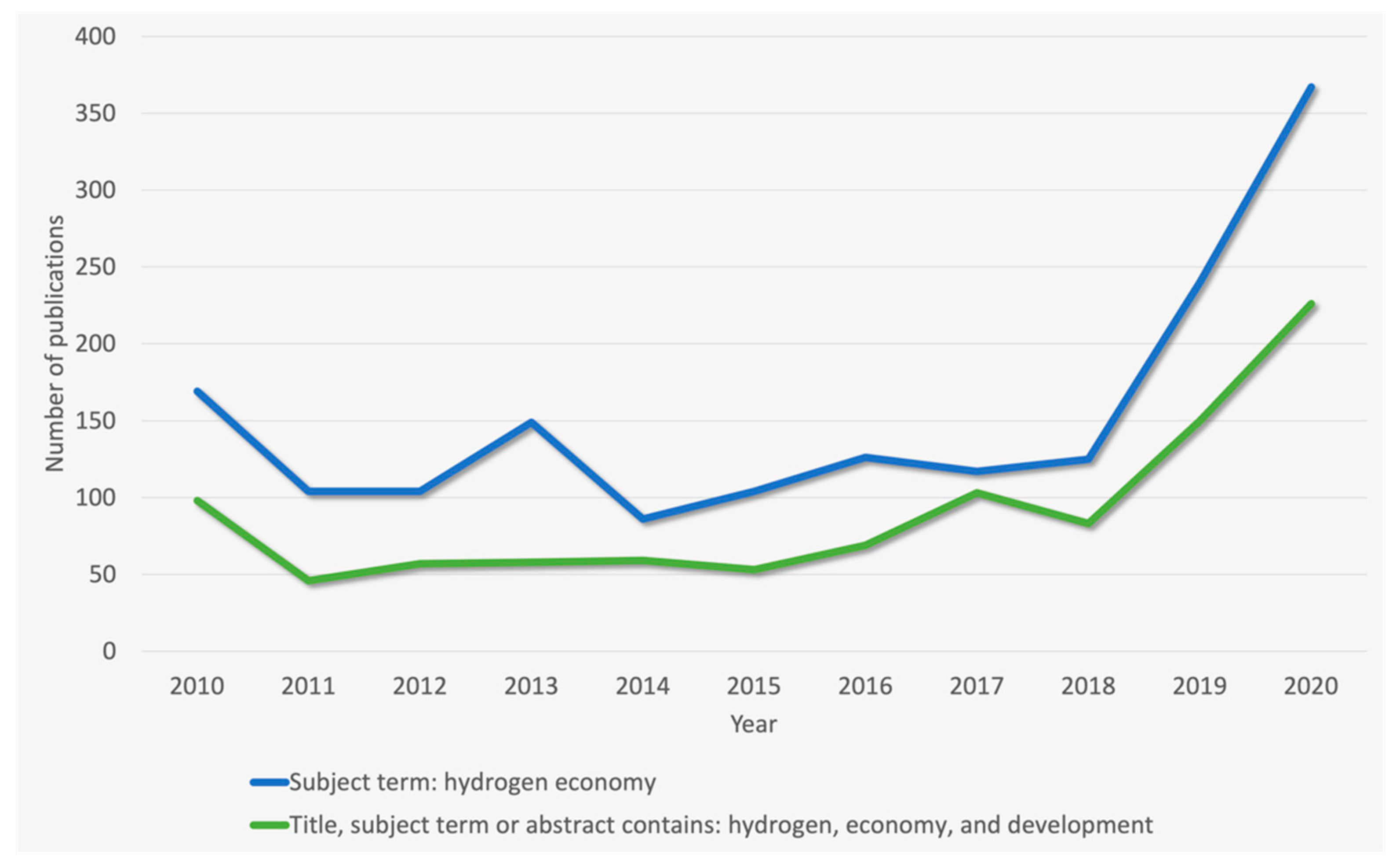
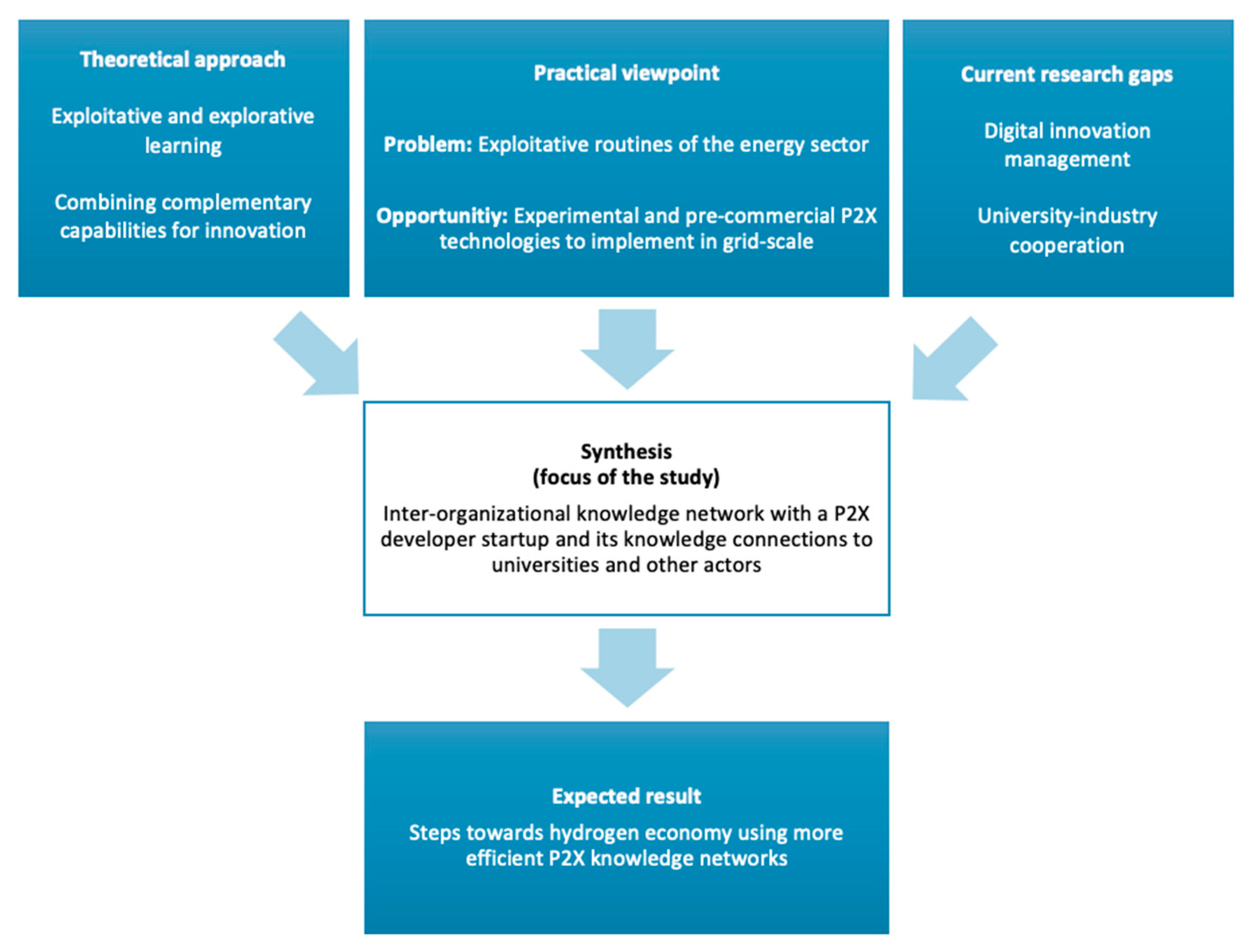
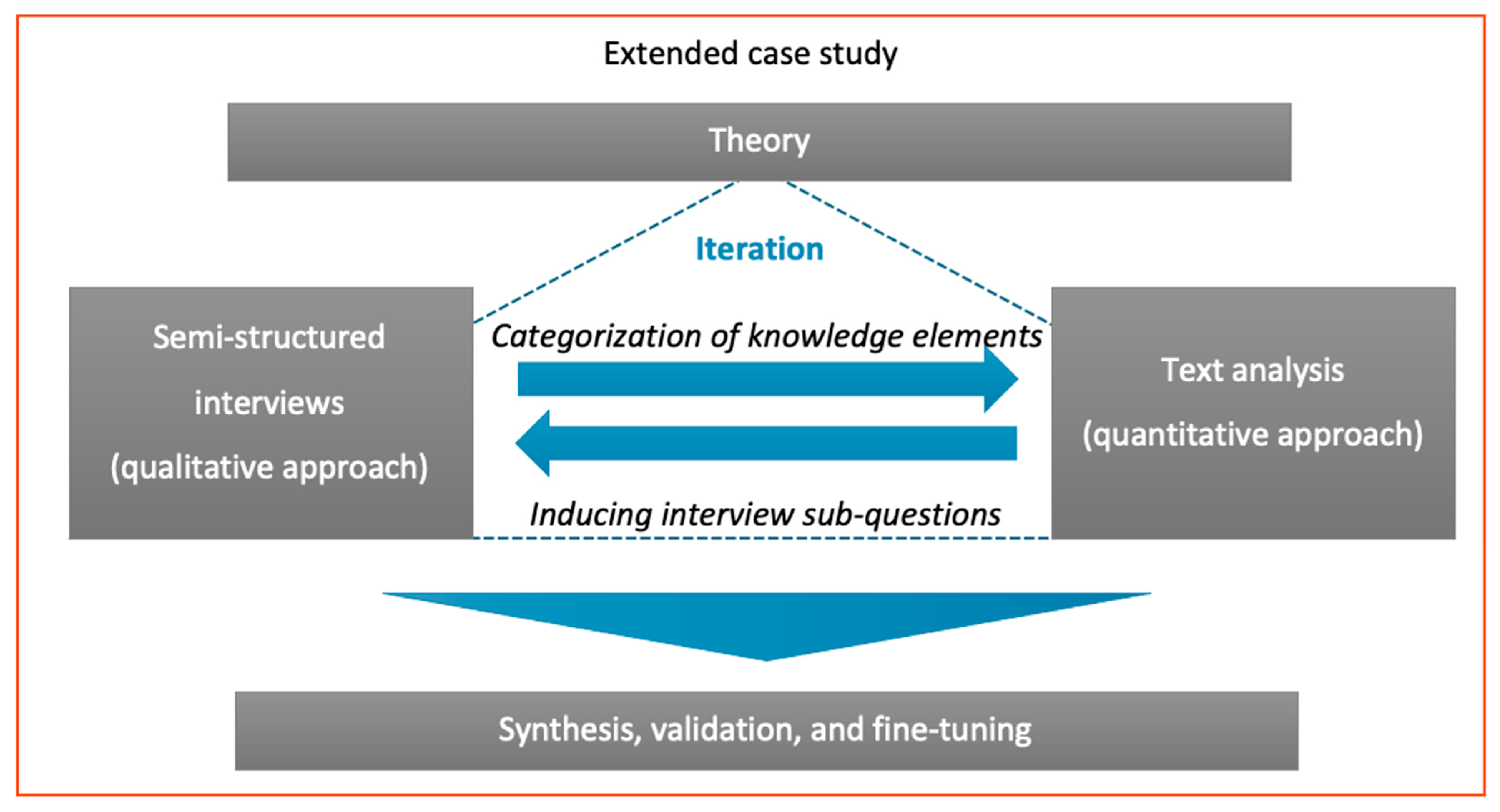
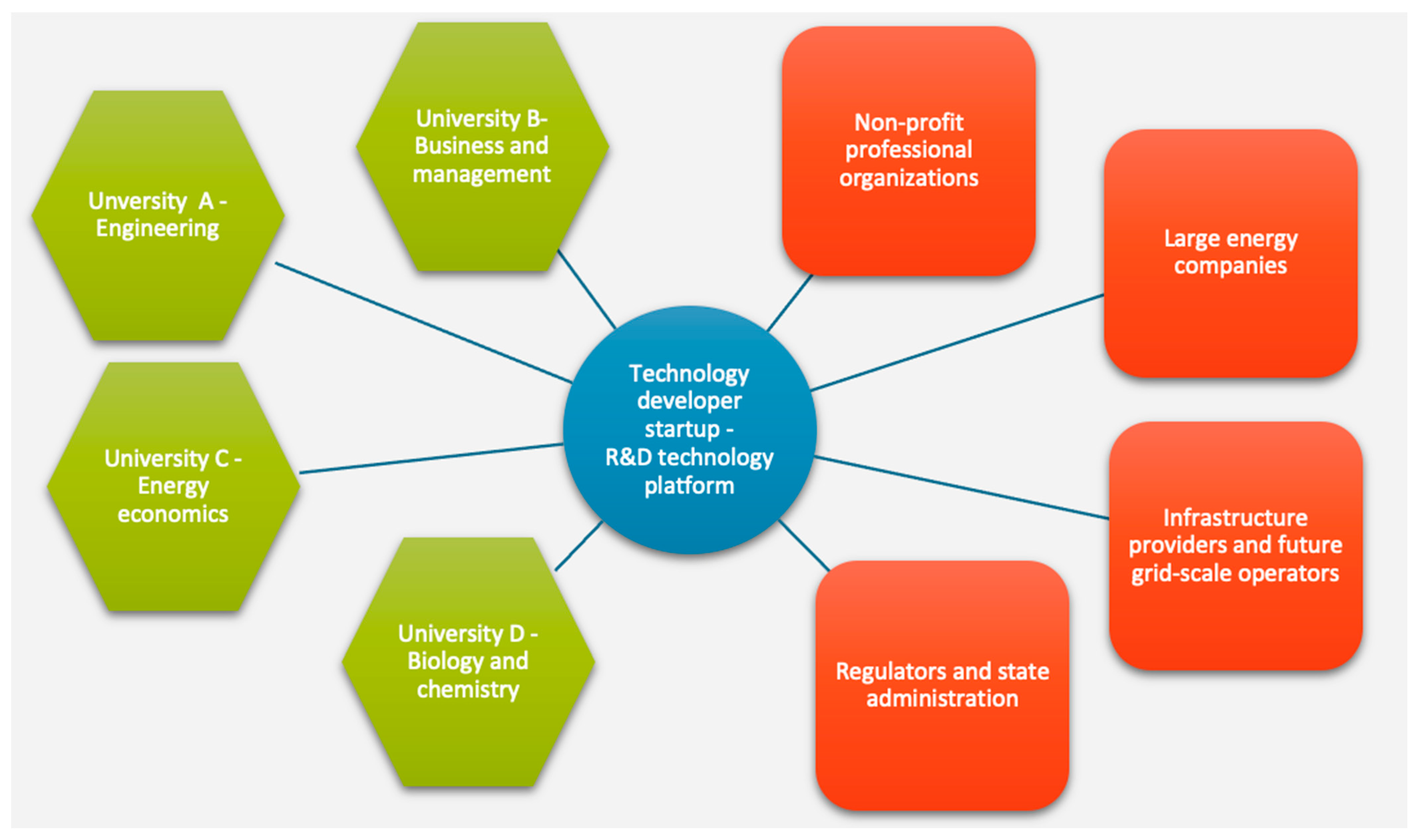
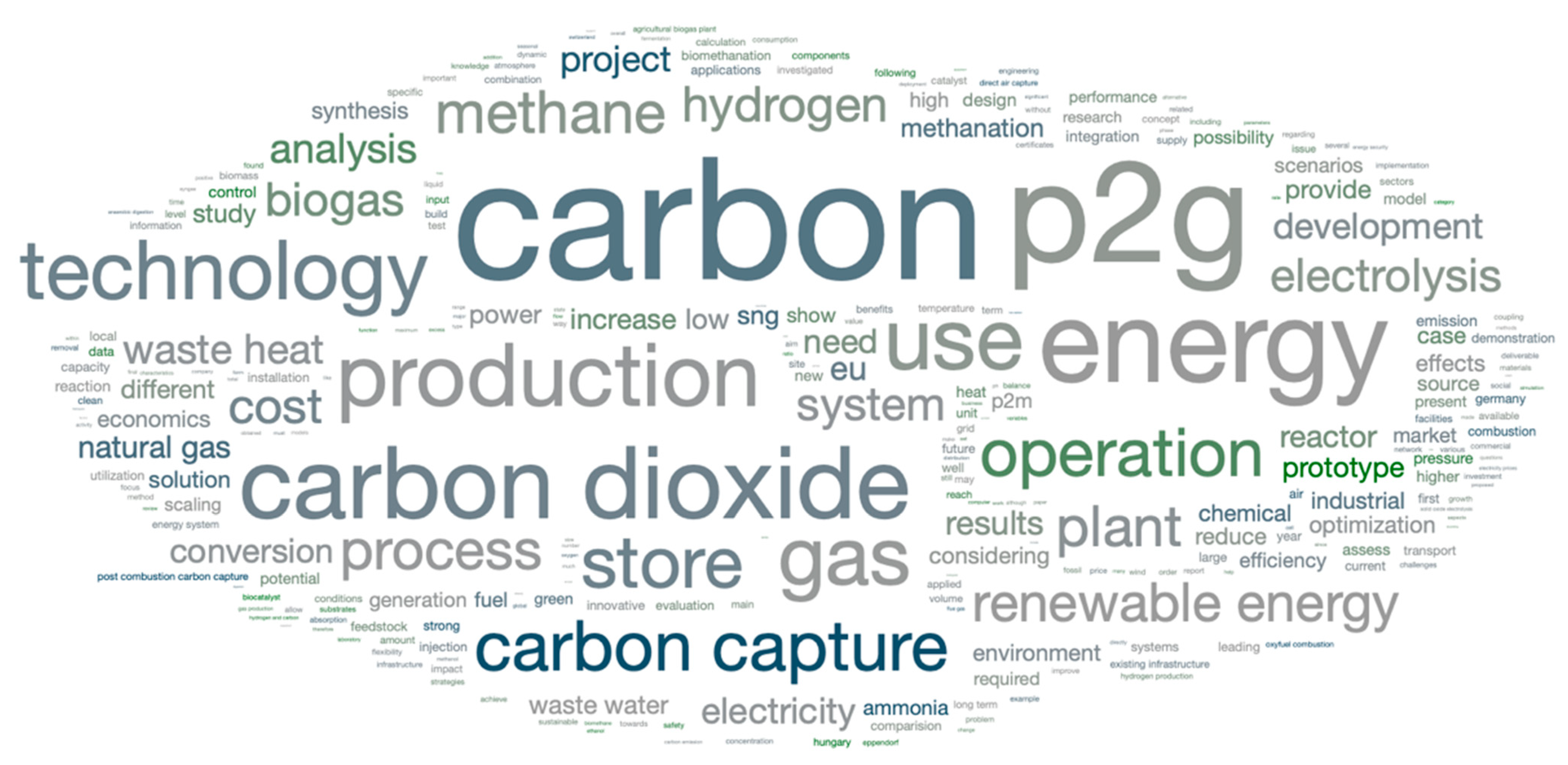

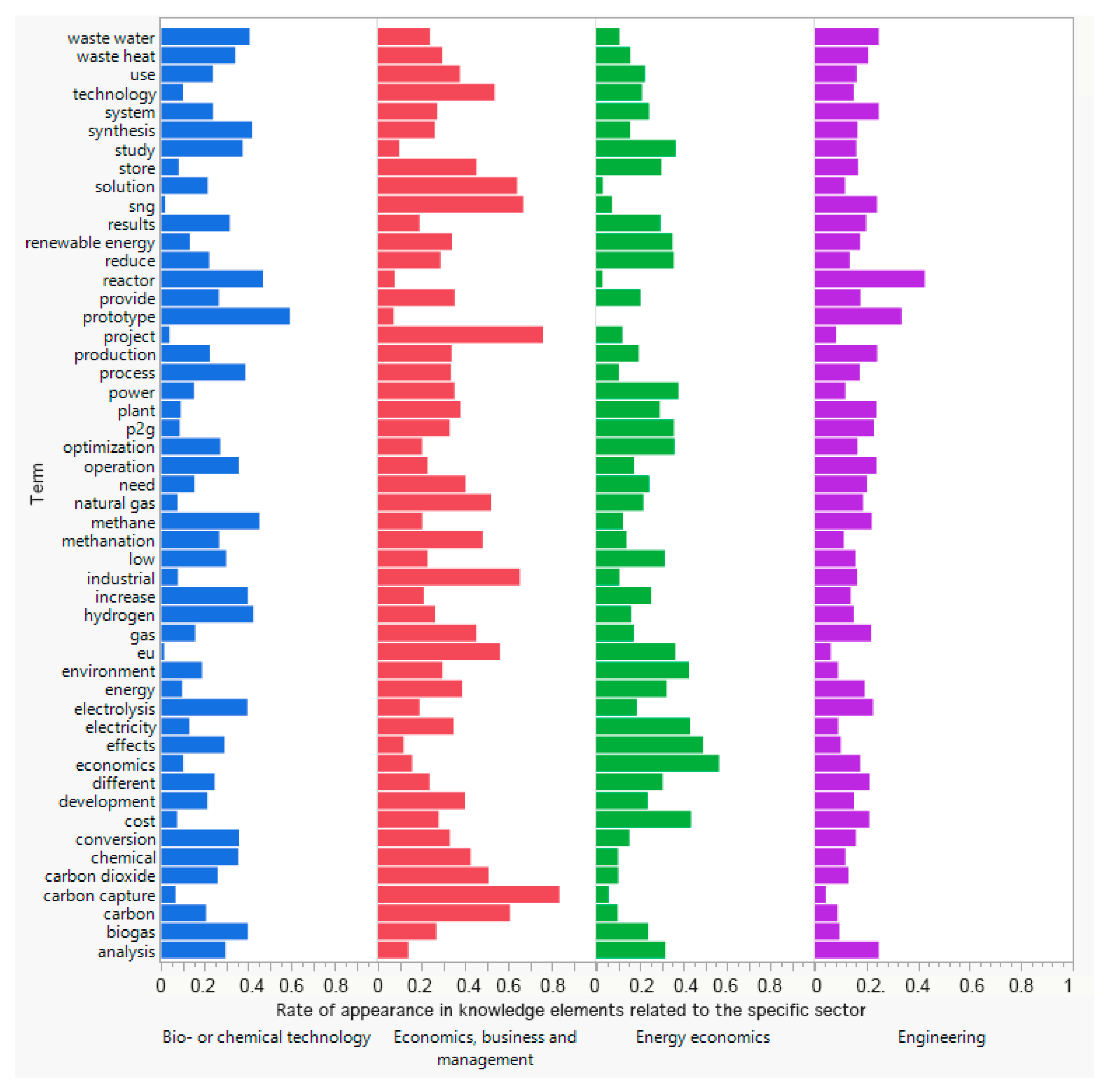
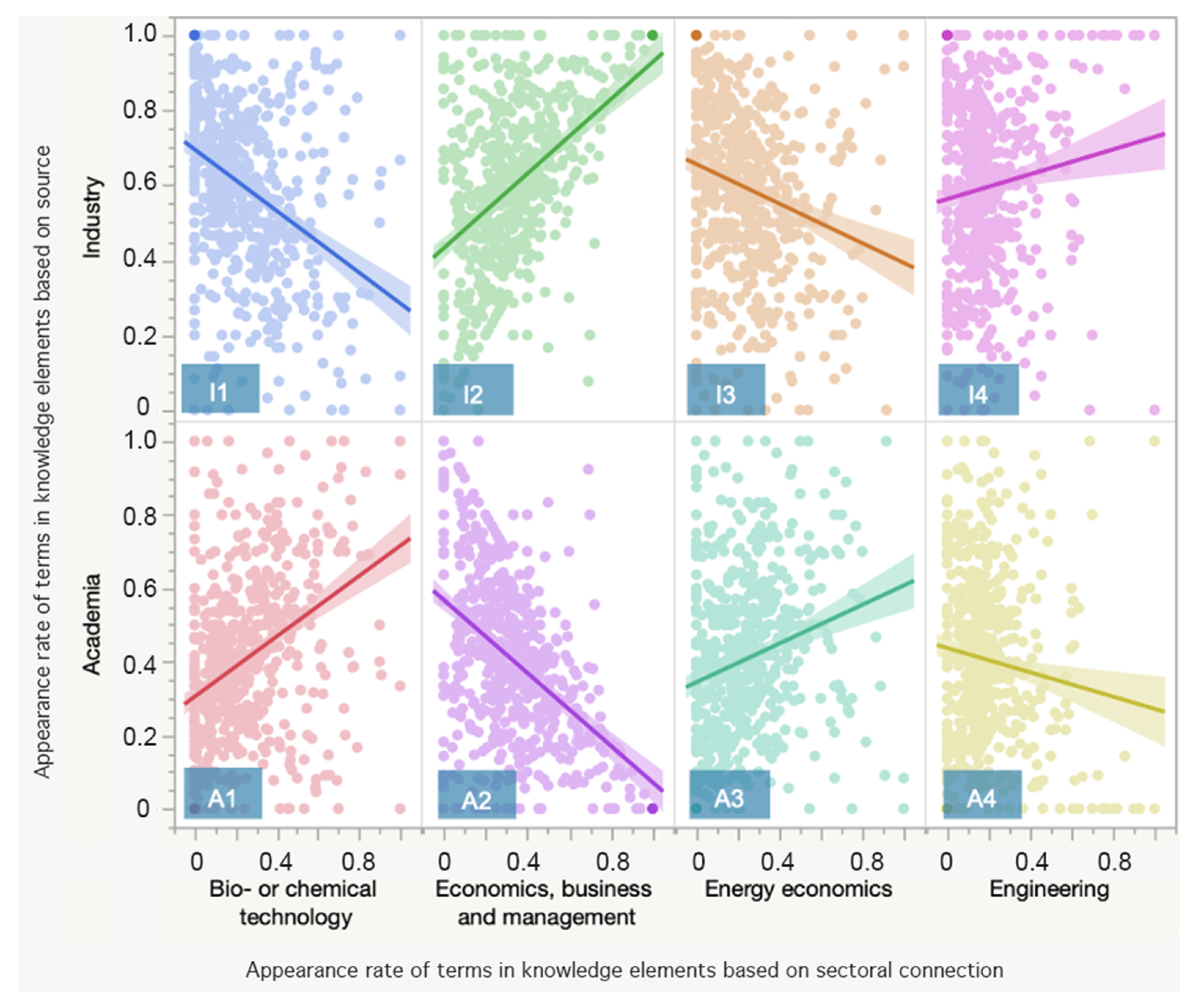
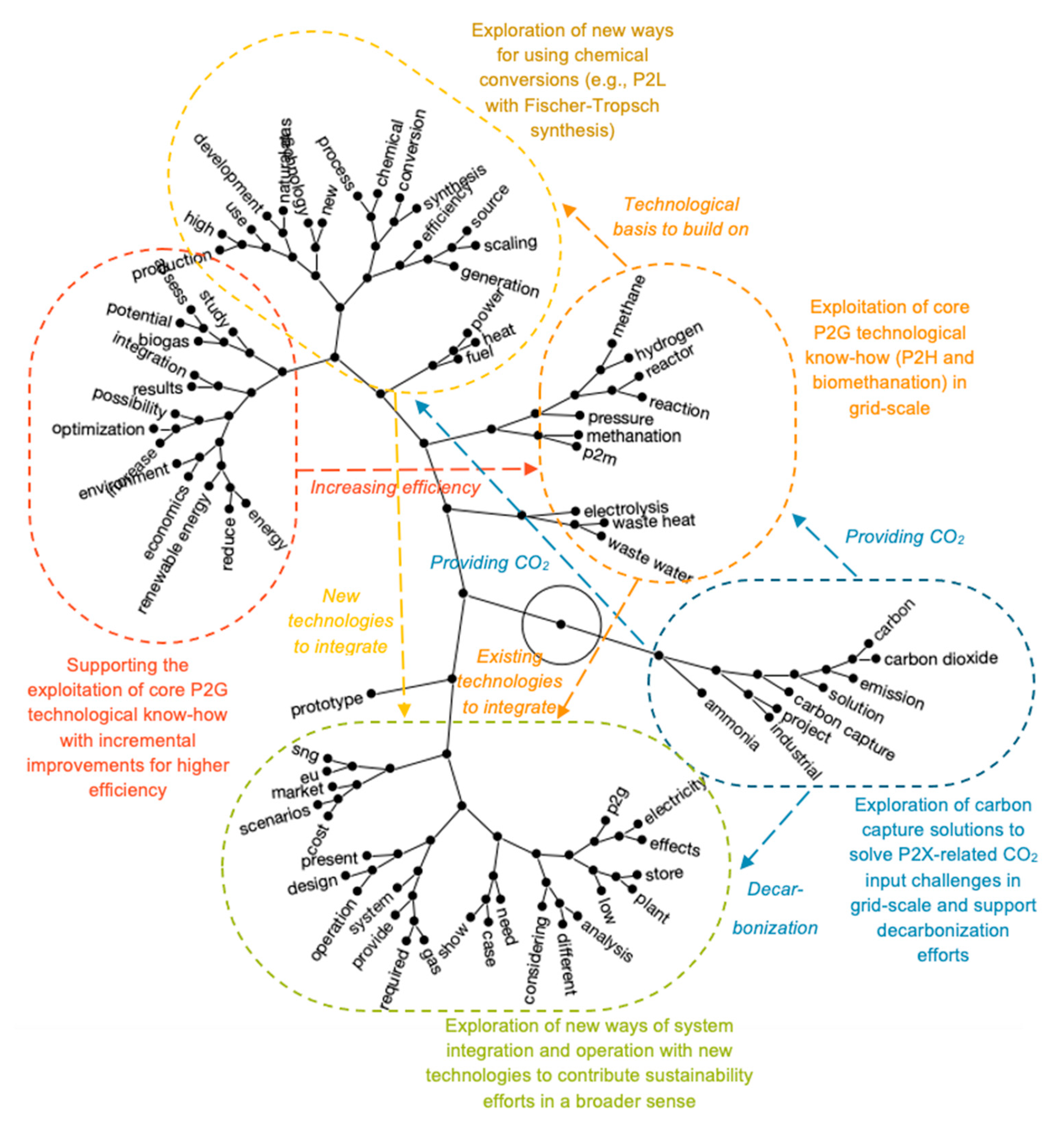

| Project | Location | H2 by: | Additional Conversion | Unique Attribute | Industrial Knowledge | Scientific Knowledge | Sources |
|---|---|---|---|---|---|---|---|
| H2orizon | Hardthausen am Kocher, Germany | PEMEL (880 kW) | - | Mobile H2 storage in a trailer | ZEAG Energie AG | German Aerospace Center (DLR) | [54,55] |
| REFHYNE | Wesseling, Germany | PEMEL (10,000 kW) | - | Largest P2H plant (under construction) | ITM Power, Shell, Sphera, Element Energy | SINTEF | [56,57,58] |
| Audi e-gas plant | Werlte, Germany | AEL (6000 kW) | Catalytic methanation | Largest P2M plant | ETOGAS, EWE Biogas, Audi | ZSW, Fraunhofer IWES | [36,59,60] |
| HELMETH | Kalsruhe, Germany | SOEL (15 kW) | Catalytic methanation | Innovative electrolysis technology | Sunfire, German Technical and Scientific Association for Gas and Water | Polytechnic University of Turin, European Research Institute of Catalysis, National Technical University of Athens | [36,59,61,62] |
| BioPower2Gas | Allendorf, Germany | PEMEL (300 kW) | Biological methanation | First commercial plant with biomethanation | Microbenergy, Viessmann Group EAM EnergiePlus, EnergieNetz Mitte | iDe (Institue of Decentralized Energy Technologies), DBFZ (German Biomass Research Centre) | [36,63,64,65] |
| BioCat | Avedøre, Denmark | AEL (1,000 kW) | Biological methanation | Patented microorganism and largest biomethanation plant | Electrochaea, Energinet, Hydrogenics, NEAS Energy, HMN Gashandel A/S, Biofos A/S, Audi, Insero | University of Chicago | [36,66,67,68] |
| Underground Sun Storage | Pilsback, Austria | AEL (500 kW) | Biological methanation | Underground methanation | RAG, Verbund, Axiom | University of Leoben, University of Natural Resources and Applied Life Sciences Vienna, Energy Institute at the Johannes Kepler University | [69,70] |
| STORE&GO-Italy | Troia, Italy | AEL (200 kW) | Catalytic methanation | P2M with CO2 from Direct Air Capture (DAC) | Climeworks AG (DAC), Studio Tecnico BFP, Engineering Ingegneria Informatica SPA, Iren SPA, ATMOSTAT, Hysytech S.R.L., Comune di Troia | Politecnico di Torino, CEA French Alternative Energies and Atomic Energy Commission | [71,72] |
| Copernicus P2X project | Karlsruhe, Germany | SOEL (10 kW) | Fischer-Tropsch synthesis | P2L with CO2 from Direct Air Capture (DAC) | INERATEC, Climeworks, Sunfire | Karlsruhe Institute of Technology | [73,74,75] |
| C3 Mobility P2L plant | Freiberg, Germany | N/A | Methanol synthesis | 12 tons of green fuel already produced for tests of car manufacturers | Chemieanlagenbau Chemnitz, Mitsubishi Hitachi Power Systems Europe | TU Bergakademie | [76,77] |
| Industry | Using chemical absorption for carbon capture (e.g., “ammonia”, “prototype”, “control”, “operation”) | Developing decarbonization projects and producing clean fuels (e.g., “carbon capture”, “project”, “green”, “SNG”) | Gaining competitive advantage on EU markets by reducing energy costs, introducing novel, more energy efficient applications (e.g., “eu”, “market”, “cost”, “scenarios”, “first”, “applications”) | Increasing efficiency using new solutions, implement them with higher pressure (e.g., “pressure”, “reactor”, “data”, “control”) |
| Academia | Modeling reactions, evaluating efficiencies (e.g., “reaction”, “performance”, “efficiency”) | Developing innovative business models with CCS/CCU technologies (e.g., “innovative”, “combustion”, “demonstration”, “carbon”) | Studying scenarios about integration and potential of relevant technologies (e.g, “assess”, “model”, “economics”, “comparison”, “potential”, “integration”) | Evaluation of efficiencies by scaling up, integration, and waste management (“integration”, “reactor”, “data”, “wastewater”, “waste heat”) |
| Bio- or chemical technology | Economics, business and management | Energy economics | Engineering |
Publisher’s Note: MDPI stays neutral with regard to jurisdictional claims in published maps and institutional affiliations. |
© 2021 by the authors. Licensee MDPI, Basel, Switzerland. This article is an open access article distributed under the terms and conditions of the Creative Commons Attribution (CC BY) license (https://creativecommons.org/licenses/by/4.0/).
Share and Cite
Csedő, Z.; Zavarkó, M.; Vaszkun, B.; Koczkás, S. Hydrogen Economy Development Opportunities by Inter-Organizational Digital Knowledge Networks. Sustainability 2021, 13, 9194. https://doi.org/10.3390/su13169194
Csedő Z, Zavarkó M, Vaszkun B, Koczkás S. Hydrogen Economy Development Opportunities by Inter-Organizational Digital Knowledge Networks. Sustainability. 2021; 13(16):9194. https://doi.org/10.3390/su13169194
Chicago/Turabian StyleCsedő, Zoltán, Máté Zavarkó, Balázs Vaszkun, and Sára Koczkás. 2021. "Hydrogen Economy Development Opportunities by Inter-Organizational Digital Knowledge Networks" Sustainability 13, no. 16: 9194. https://doi.org/10.3390/su13169194
APA StyleCsedő, Z., Zavarkó, M., Vaszkun, B., & Koczkás, S. (2021). Hydrogen Economy Development Opportunities by Inter-Organizational Digital Knowledge Networks. Sustainability, 13(16), 9194. https://doi.org/10.3390/su13169194









